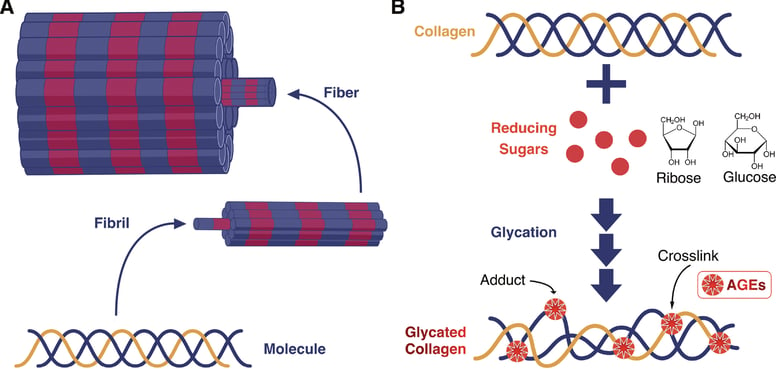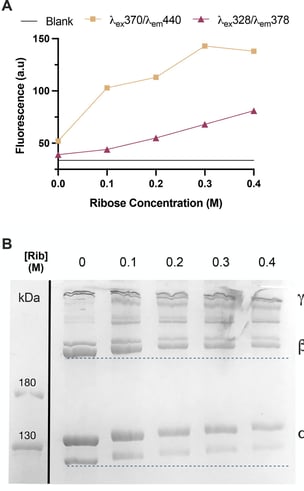
Anti-Glycation Brightening Complex™:
Cellular Strategies for Skin Clarity and Defense
Anti-Glycation Brightening Complex™: Cellular Strategies for Skin Clarity and Defense
Abstract
Anti-Glycation Brightening Complex™ is a scientifically formulated supplement designed to combat the visible effects of glycation and oxidative stress on the skin. The formulation combines glutathione, arbutin, rosehip extract, and hyaluronic acid to support a more even, luminous complexion while protecting dermal proteins from sugar-induced damage.
Introduction
Skin dullness, uneven tone, and premature aging are strongly associated with advanced glycation end-products (AGEs)—toxic compounds formed when sugars bind to proteins like collagen. Glycation stiffens and degrades skin structure while promoting pigmentation and oxidative stress. Strategies to defend against this include antioxidant replenishment, inhibition of melanin synthesis, and hydration of the dermal matrix.
Formulation Rationale
Anti-Glycation Brightening Complex™ leverages a targeted combination of bioactives that intervene at multiple stages of pigmentation and glycation-induced dermal dysfunction.
Active Ingredients & Mechanisms
• Reduced Glutathione – A master intracellular antioxidant that regulates redox signaling, detoxifies peroxides, and inhibits melanin synthesis by suppressing tyrosinase activity.
• Arbutin – A natural derivative of hydroquinone, arbutin competitively inhibits tyrosinase, reducing the formation of melanin and improving the appearance of hyperpigmentation.
• Rosehip Extract – Rich in vitamin C, carotenoids, and flavonoids, rosehip enhances antioxidant protection and supports collagen regeneration. Data show >70 mg/g total polyphenols.
• Sodium Hyaluronate – Provides deep dermal hydration, improving skin plumpness and aiding barrier repair.
• Vitamin C – A cofactor in collagen synthesis and known to reduce oxidative stress and brighten skin tone.
Scientific Support
• Glutathione has been shown in clinical studies to reduce oxidative skin damage and contribute to pigmentation balance when administered orally.
• Arbutin is widely studied as a safe depigmenting agent and is well-tolerated in long-term applications.
• Rosehip extract contributes to collagen support and photoprotection through its flavonoid and vitamin C content.
Conclusion
Anti-Glycation Brightening Complex™ provides a molecularly informed strategy to mitigate skin dullness, oxidative stress, and uneven tone. Its design reflects scientific understanding of glycation biology, melanogenesis regulation, and skin barrier function support.
This article is intended for educational purposes. ENVILT products are not intended to diagnose, treat, cure, or prevent any disease. Results may vary by individual physiology and lifestyle factors.
References:
Berlan, M., et al. (2002). Effects of Sinetrol®, a citrus flavonoid extract, on lipid metabolism in overweight individuals: a randomized clinical trial. Phytotherapy Research, 16(5), 479–483.
Gutiérrez, A. L., & Pardo, V. (2018). Effects of PQQ supplementation on mitochondrial biogenesis and metabolic markers. International Journal of Molecular Sciences, 19(6), 1806. https://doi.org/10.3390/ijms19061806
Cavallo, M. G., et al. (2004). Chromium picolinate in type 2 diabetes mellitus: effects on glucose and lipid metabolism. Diabetes Care, 27(8), 2211–2216.
Ready to defend your skin against sugar-induced aging?
Discover Anti-Glycation Brightening Complex™
a precision blend for clarity, balance, and antioxidant protection.


Fig. 1. Collagen structure and glycation. (A) Visual representation of different structural levels of collagen type I organization. Banding is meant to represent gap and overlap regions found in assembled fibrils and is not to scale. Type I collagen is comprised of two identical a2 (blue) chains and one a2 (yellow) chain. (B) Glycation of collagen. Sugars including ribose and glucose can participate in glycation. Reactive amino groups found on lysine and arginine residues commonly participate in AGE formation. AGEs can modify a single site to form an adduct or two adjacent sites to form a crosslink.


Fig. 2. Confirmation and tracking of collagen glycation progression. (A) Fluorescence measured at λex = 370 nm, λem = 440 nm was used to track general AGE presence while fluorescence at λex= 328 nm, λem= 378 nm corresponds to pentosidine. Both signals increase with the concentration of ribose used for treatment. (B) Denaturing SDS-PAGE gel of collagen following incubation with different concentrations of ribose. The dotted lines are for visual reference of mobility changes. All samples had been incubated with ribose for 350 days.



